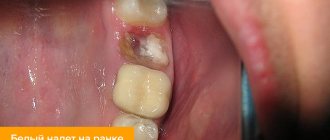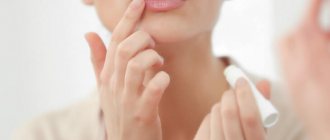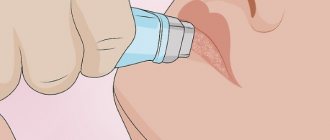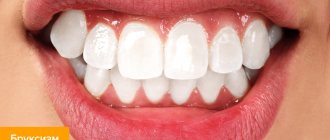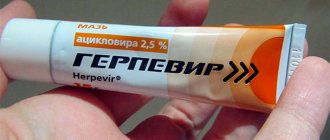Factors causing angulitis
Seizures (angulitis, angular stomatitis) are a type of skin lesion that is located in the corners of the mouth. The causes of this disease are as follows:
- increased reactivity of the immune system of an allergic nature, often seizures are one of the accompanying diseases, for example, with eczema, atopic dermatitis;
- the occurrence of some chronic infection in the body against the background of immunodeficiency;
- diabetes mellitus (the mechanism is the same as during the formation of a diabetic foot, when tissue trophism is disrupted);
- hypo- and vitamin deficiency, especially for B vitamins;
- long-term and intensive antibacterial therapy (destroys beneficial microflora, as a result of which opportunistic microflora is activated);
- serious changes in hormonal levels, physiological (adolescence, pregnancy) and pathological (with disturbances in the functioning of the endocrine glands).
Diagnostics
After a physical examination with the collection of complaints, a visual examination of the oral cavity and problem areas of the skin, and clarification of the supposed causes of the pathology, appropriate diagnostic measures will be prescribed aimed at identifying the disease that led to such manifestations
Necessary diagnostic methods:
- Bacterial seeding of the contents of conflict with identification of the pathogen and determination of its sensitivity to chemotherapeutic drugs.
- Analysis of immune status to determine functional and quantitative indicators of the state of the immune system.
- Serological studies. Prescribed to identify the cause of seizures, for example, to determine antibodies to the pale spirochete that appear with syphilis.
- Dermatoscopy is a visual assessment of pathologically changed areas of the skin using a digital or optical dermatoscope, which repeatedly magnifies the tissue being examined. The study is necessary for the differential diagnosis of a seizure with a nevus, malignant neoplasm, hemangioma, etc. Prescribed for suspected streptococcal impetigo.
- Skin pH-metry is a diagnostic method that allows you to determine the acid-base balance of the skin using special pH meters. The disease is detected depending on whether the displacement has occurred into an alkaline or acidic environment. Alkalinization of the epidermis occurs in eczema and atopic dermatitis. A shift to the acidic side indicates psoriasis.
- Histology and cytology of altered skin. These are optional studies carried out according to indications to exclude an oncological process.
Reading: Leukemia
Based on the suspected cause of the cracks, you may need to consult a venereologist, endocrinologist, neurologist or allergist.
Varieties of jam
Thus, angulitis can be an allergic inflammation, or a bacterial infection that occurs against the background of weakened immunity and/or impaired trophism of the skin in the corners of the mouth. Allergic seizures are easily identified - they occur after eating some food that is an allergen for the patient. Or the food itself may be overly irritating (spicy, sour). Allergic seizures are often a concern in childhood, when the level of allergic reactivity is especially high. In all other cases, the development of seizures is associated with the addition of an infection:
- Streptococcal infection. It begins with the formation of a vesicle in the corner of the mouth, which quickly resolves, leaving a small, slightly bleeding erosion. The erosion quickly heals with a purulent-bloody crust. The crusts may peel off and grow back. The jam when moving your mouth can be a little painful. Often develops against the background of bacterial tonsillitis in children.
- Candida infection (opportunistic fungi of the genus Candida). Here the erosion is not covered with a crust, but is framed by softened epithelium. An easily removable grayish film may appear on the wound. This jam is less noticeable when the mouth is closed.
- Less commonly, seizures are caused by viruses. If this happens, then with a 95% probability it is a herpes virus type 1 or 2.
The choice of drugs depends entirely on the etiology of angulitis. The nature of the pathology is determined by a dermatologist during a clinical examination, and the exact infectious pathogen is identified by taking a scraping.
Why do some people get sticky spots on their lips and others don’t?
Doctors do not yet have a clear answer. But it is assumed that two factors play a key role here: the tendency for saliva to accumulate and the characteristics of personal immunity.
Each of us, at one period of our lives, can be extremely susceptible to the appearance of angulitis, and in another, we will not get sick, even if we constantly lick our lips.
You are at risk in the following cases:
- The shape of your mouth is such that there are creases at the corners of your lips where saliva can accumulate.
- You have decreased tone of your facial muscles. They sag, forming creases. This problem is pronounced, for example, in people with Down syndrome.
- You wear dentures. If they are poorly fitted, it can cause saliva to accumulate in the corners of the lips.
- You have thrush in your mouth.
- You suffer from tooth decay and gum disease. In this case, there may be more microbes in your mouth than you would like.
- You have a viral infection affecting your mouth. Even a common ARVI can provoke the appearance of angulitis.
- You are diabetic. With this disease, the skin becomes vulnerable Diabetes Overview: Skin Complications to infections and immunity decreases.
- Your immune system is weakened. This may be due to certain medications, chemotherapy, and certain diseases such as HIV or AIDS.
- You are anemic. Its researchers also link Angular Cheilitis, Part 2: Nutritional, Systemic, and Drug-Related Causes and Treatment with an increased risk of angular cheilitis. It is assumed that iron deficiency may reduce immunity. Anemia is caused, among other things, by an unbalanced diet or harsh diets. If you don't eat right, don't be surprised when you overeat.
- You are an elderly person. With age, the facial muscles sag, folds form near the lips, and the immune system becomes weaker.
- You have an autoimmune disease. For example, lupus, Crohn's disease, ulcerative colitis.
Treatment of allergic angulitis
If the seizure is of an allergic nature, then antihistamines are first prescribed. The generation of the drug does not play a special role here. It’s just that Suprastin (Chloropyramine, 1st generation) causes severe drowsiness and sometimes headache, and its effect may weaken over time (allergic resistance). Whereas Erius (Desloratadine, 3rd generation) not only competitively binds to histamine receptors, but also inhibits the synthesis of histamine itself. And the side effects are much less pronounced. The “golden mean” is Loratadine - a 2nd generation drug that has almost no side effects, is almost as effective as Erius, but is several times cheaper.
In case of severe allergic inflammation, short-term use of hormonal ointments is permissible: Akriderm, Sinaflan, Advantan, Fenistil, etc. However, for children under 12 years of age, hormonal ointments are prescribed only as a last resort. As a softer analogue of hormonal ointments, you can use Vishnevsky's liniment. But not longer than 10 days, and care must be taken to ensure that the child does not accidentally lick off the applied drug. We must remember that there is always a risk of infection joining allergic inflammation. Considering that children often comb out bumps with unwashed hands.
Treatment of infectious angulitis
When angulitis develops due to infection, then the appropriate remedy is needed. Fukortsin is often prescribed as the first line, which has both antibacterial and antifungal activity, and forms a long-term, protective film at the site of damage.
In eliminating bacterial infections, Metrogyl Denta gel, containing Metronidazole and Chlorhexidine as active ingredients, has gained great popularity. Older, but also effective combined broad-spectrum agents are ointments: Methyluracil ointment and Trimistin. Tetracycline ointment and Levomekol are excellent against streptococcal infections.
If the infection is of a fungal nature, then the main treatment is antifungal ointments: Levorin, Nystatin, sulfur-salicylic, and Clotrimazole. Acyclovir is most often prescribed against herpes lesions in the mouth.
Seizures in the corners of the mouth: treatment with ointments
At home, when seizures occur, antiseptic, antibacterial, antifungal and combination ointments are used, depending on the pathogen. Antibacterial and antifungal agents are more effective than antiseptics, since they not only prevent the proliferation of microorganisms, but also contribute to their death. Good results can be achieved by combining solutions and ointments.
Below are the TOP 5 types of ointments for treating seizures at home:
| Name of ointment | Description |
Ointments with antiseptic effect:
Prescribed for the following cases: common and uncomplicated streptococcal and candidal infections. | Ointments can be applied to the corners of the lips and surrounding areas of the skin in a thin layer, but a better effect can be achieved with ointment compresses. To do this, the medicine is applied to a sterile napkin and fixed in the corners of the lips with an adhesive plaster overnight. Antibacterial ointments are ineffective against fungal infections; moreover, they can aggravate the course of candidiasis. Levomekol ointment is not suitable for treatment in the lip area. Oxolinic ointment and Acyclovir are ineffective against streptococcal and candidal infections. |
Antifungal agents (fungicides):
Prescribed for the following cases: candidal infections. | Antifungal ointments are used by applying them to the corners of the mouth in a thin layer or in the form of compresses 3-4 times a day. Fungicide solutions are used to treat not only the corners of the mouth, but also the entire oral cavity. This is necessary for the treatment or prevention of candidal stomatitis. Fungicides are ineffective against streptococcal infections. |
Antibacterial agents:
Prescribed in the following cases: streptococcal seizures | Ointments can be applied to the corners of the lips and surrounding areas of the skin in a thin layer, but a better effect can be achieved with ointment compresses. To do this, the medicine is applied to a sterile napkin and fixed in the corners of the lips with an adhesive plaster overnight. Antibacterial ointments are ineffective against fungal infections; moreover, they can aggravate the course of candidiasis. Levomekol ointment is not suitable for treatment in the lip area. Oxolinic ointment and Acyclovir are ineffective against streptococcal and candidal infections. |
Combined ointments:
Prescribed for the following cases: chronic seizures, seizures caused by a mixed infection, in the presence of concomitant atopic dermatitis in the area around the mouth. | Combined ointments contain an antibiotic, an antifungal component and a glucocorticosteroid hormone. These remedies can only be prescribed by a specialist when other treatment methods do not help. |
Remedies that promote rapid healing of a seizure:
Prescribed in such cases: all types of jam. | In order to quickly get rid of jams, in addition to antibacterial ointments and antiseptics, use ointments that promote wound healing. But you need to know that these ointments are not prescribed from the first day of therapy. They are connected to the main treatment when the first positive results appear: on the 2-4th day. Healing ointments are applied in a thin layer 3-4 times a day at least an hour after using antibacterial ointments. |
To read: Mastoiditis
Usually, seizures do not require general treatment; they heal with the use of only local medications. But if the lesions have spread to large areas of the skin, do not heal for a long time and are associated with immunity problems, then the use of general remedies is necessary. They are prescribed only by a doctor.
Additional measures and prevention
In addition to therapy that eliminates the cause, auxiliary therapy is required to prevent relapses. Vitamin ointments Panthenol and Bepanten, providing the skin with additional pantothenic acid. Vitaon (one of Karavaev’s balms) is a complex complex based on plant substances (essential oils, calendula, fennel, rose hips, pine, chamomile, mint, St. John’s wort, etc.). Vitaon accelerates regeneration processes, inhibits the development of inflammation and has a slight antiseptic effect. Zinc paste creates good protection against excessive evaporation of moisture from the epidermis and protects against re-entry of microorganisms. And of course, you need proper, fortified nutrition. Skin health is primarily affected by a lack of vitamin B2 in food.
